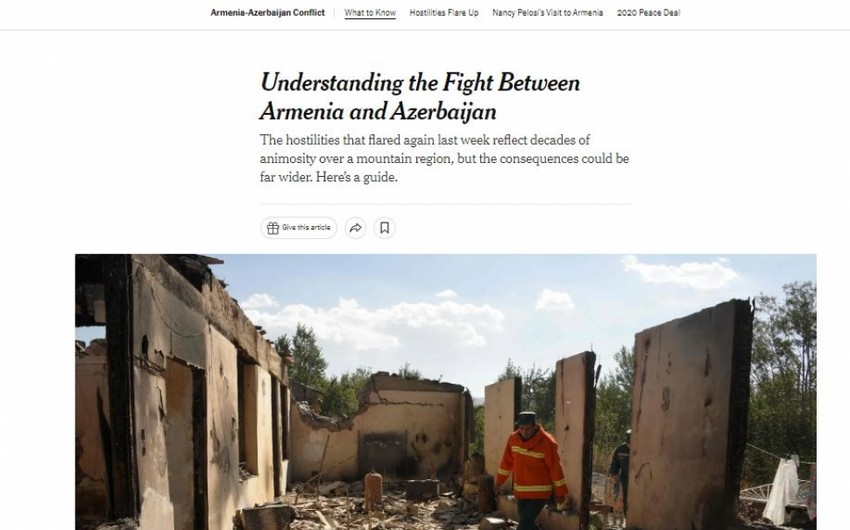Matthew Mpok Bigga's article titled "Understanding the conflict between Armenia and Azerbaijan" on recent border tension between Armenia and Azerbaijan was published in The New York Times of the US, Report informs.
The author noted that Secretary of State Antony Antony Blinken met the foreign ministers of Armenia and Azerbaijan in New York this week for the first direct talks since more than 180 people were reported killed last week in fighting between the two countries. The flare-up subsided within days, but the high-level meeting reflects worries that the causes of the conflict — and the full-scale war that preceded it in 2020 — are nowhere near resolved. Those worries are aggravated by the underlying geopolitical tensions.
The article said that Russia is a longtime protector of Armenia. Turkiye, a NATO member, is a key ally for Azerbaijan and backed it in the 2020 war. And although US diplomats have sought to maintain a mediating role, Speaker Nancy Pelosi stepped into the middle of the fray last weekend, visiting Armenia to show support and declaring that the recent violence "was initiated by the Azeris."
The trip was widely seen as a political move by Ms. Pelosi ahead of the midterm elections in November. She was accompanied by Representatives Jackie Speier and Anna G. Eshoo, both Armenian Americans from her home state of California, where there is a large Armenian community.
Here's a guide to what happened in the most recent clashes, what lies behind them, and the potential stakes of the dispute. The conflict centers on a region disputed for decades.
The article added that the mountainous region of Nagorno-Karabakh has long been at the heart of tensions between Armenia and Azerbaijan. Internationally recognized as part of Azerbaijan, but with a majority ethnic Armenian population, it declared independence in the late Soviet period.
Matthew Mpok Bigga noted that A cease-fire brokered by Russia left Azerbaijan holding most of the territory, with Armenian forces pulling back and heavily armed Russian peacekeepers moving in. Now, analysts say, Azerbaijan is pushing to have Armenia recognize Azerbaijani sovereignty over Nagorno-Karabakh, and to make other concessions.
He said that the latest flare-up was elsewhere. Each side has a different story about how the fighting started last week. Armenia said that Azerbaijan attacked and that 105 of its service members were killed and six civilians wounded. Azerbaijan said its military actions were "retaliatory measures" in response to provocation from Armenia, and it reported 71 of its service members were killed. Although tensions between the two countries spring from who controls Nagorno-Karabakh, fighting this time took place directly between Armenia and Azerbaijan, where the border remains undemarcated.
The United Nations said that heavy fighting involving artillery and drones had been reported along the international border between the two nations on September 12. Azerbaijan's Ministry of Foreign Affairs spoke of "an incident" on "the deemed border," but Armenia said Azerbaijan had attacked three towns in Armenia itself: Jermuk, Goris, and Kapan.
According to the author, Azerbaijan is pressing its demands, but Armenia looks to be playing for time. Armenia's prime minister, Nikol Pashinyan, has said he intends to come to terms, but his domestic opponents have denounced the sort of deal that would be on the table as treasonous. He already faced angry protests after the 2020 cease-fire.
Analysts said that Azerbaijan's government had three demands: a renunciation by Armenia of its claims in Nagorno-Karabakh, the demarcation of the international border on its terms, and security control of a yet-to-be-built road and rail corridor to Nakhchivan, an island of Azerbaijani territory inside Armenia. That would also connect Azerbaijan with Turkiye.
For Russia and Turkiye, it's a delicate situation. Russia has laid claim to two roles in this dispute, brokering cease-fire deals while also guaranteeing Armenia's security. The first role has so far helped it avoid the full potential costs of the second. But Moscow may also find its double role in the South Caucasus harder to maintain if the situation grows more dangerous.
Paul Stronski, a senior fellow at Carnegie Endowment for International Peace in Washington, said that 'Azerbaijan's military action amounted to probing that aimed to alter the facts on the ground where possible and to press Armenia to negotiate a treaty on its terms.'
Global powers are calling for peace. But some also need natural gas. Blinken this week urged the two sides to return to negotiations and prevent further hostilities.
Washington has long sought influence in the South Caucasus and other states in the former Soviet empire. The European Union, meanwhile, has redoubled efforts for a peace deal since the 2020 war: The leaders of Armenia and Azerbaijan held peace talks in Brussels in late August under the auspices of a top EU official, Charles Michel. But Europe's position is now complicated by its search for additional natural gas supplies to make up for the loss of Russian imports given the war in Ukraine. In mid-July, the European Commission president, Ursula von der Leyen, visited Azerbaijan to sign an agreement with Azerbaijan's president, Ilham Aliyev. During the visit, she said Azerbaijan was a "reliable, trustworthy" partner.


 https://static.report.az/photo/49f46777-4cbf-3eeb-b73f-ee505dfe8b71.jpg
https://static.report.az/photo/49f46777-4cbf-3eeb-b73f-ee505dfe8b71.jpg

